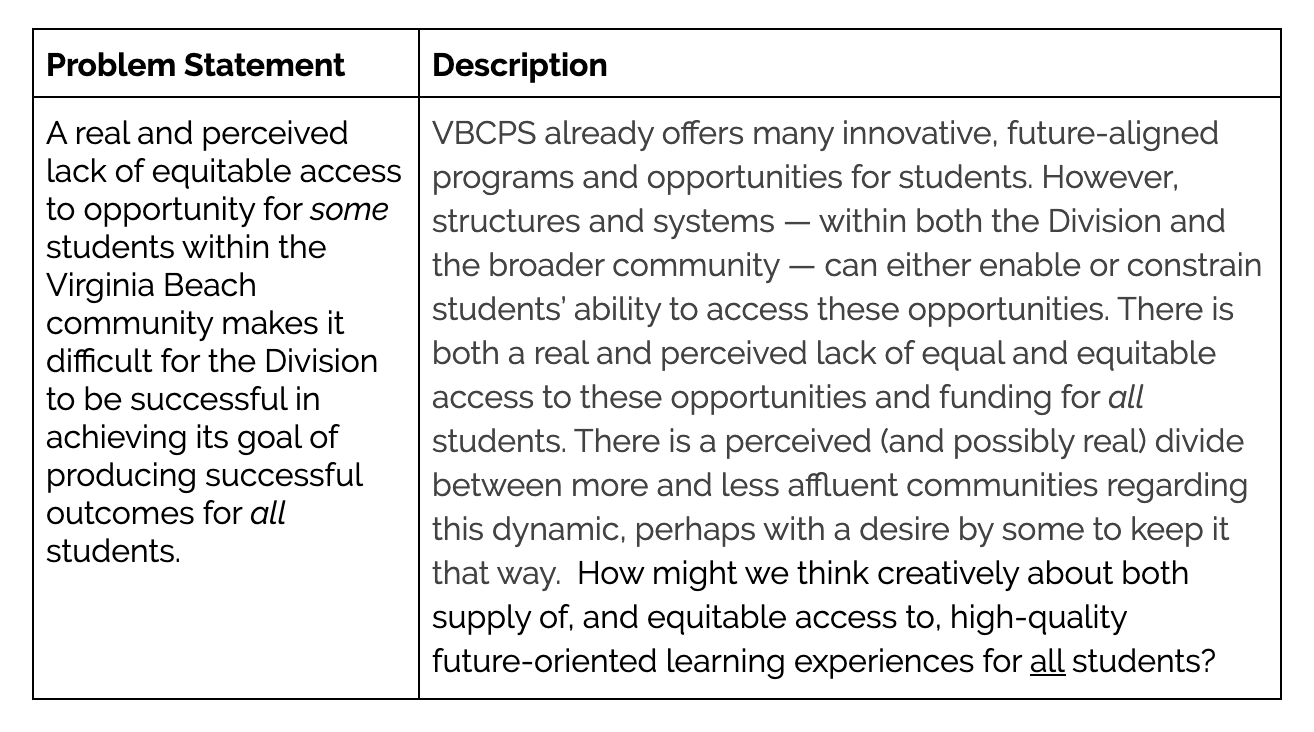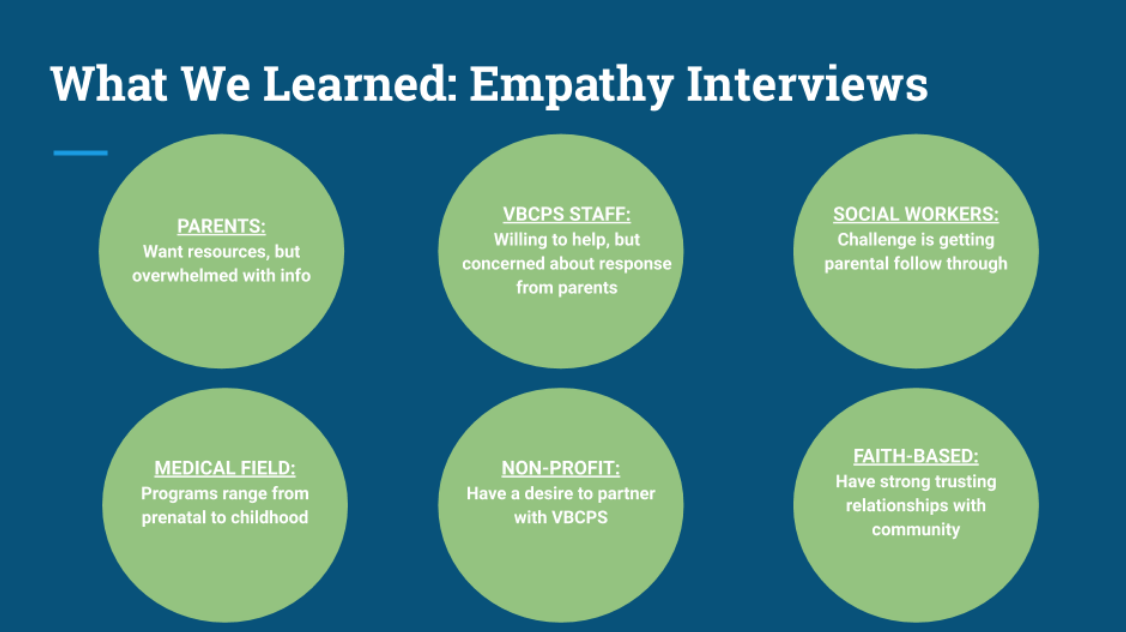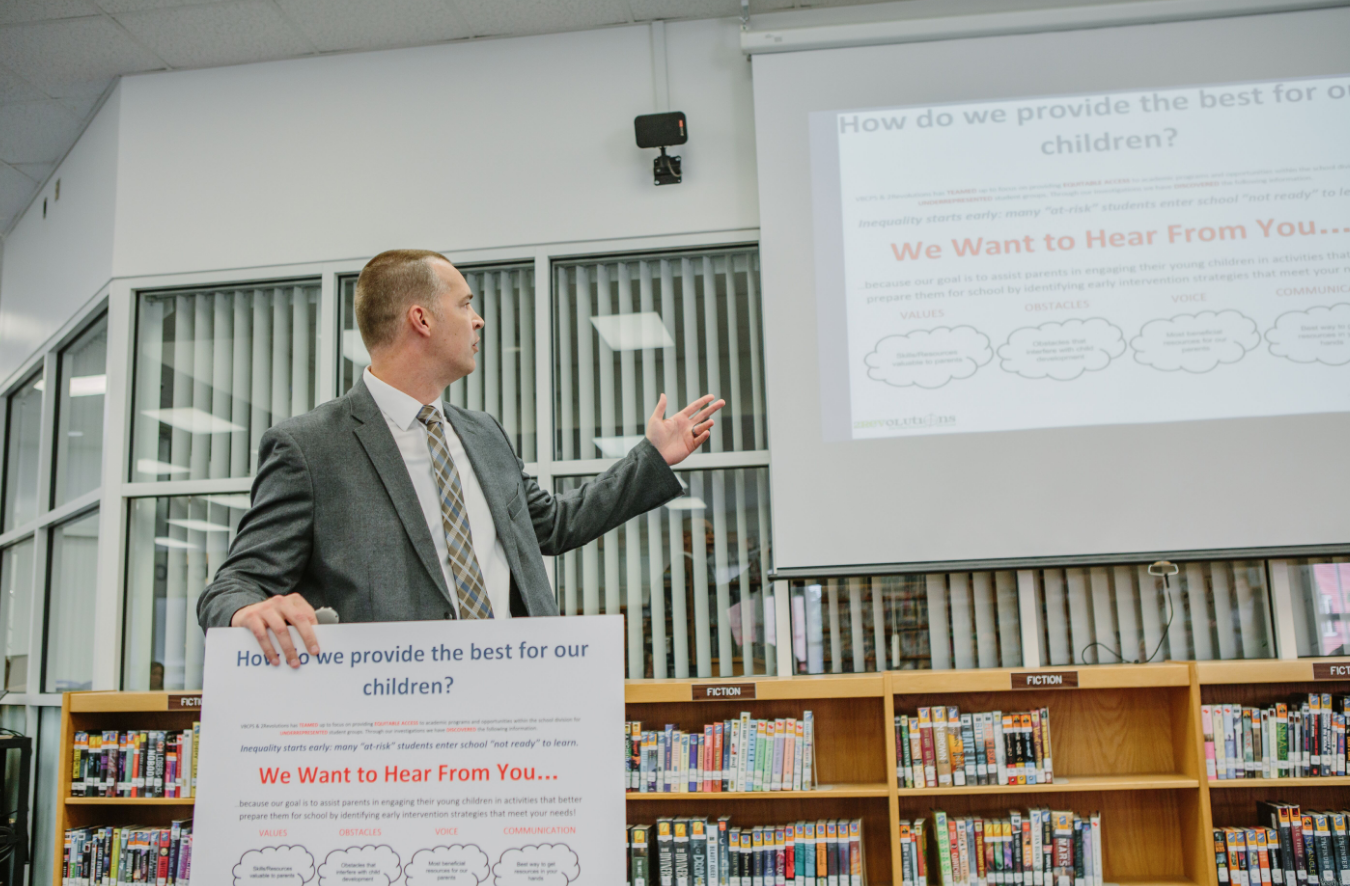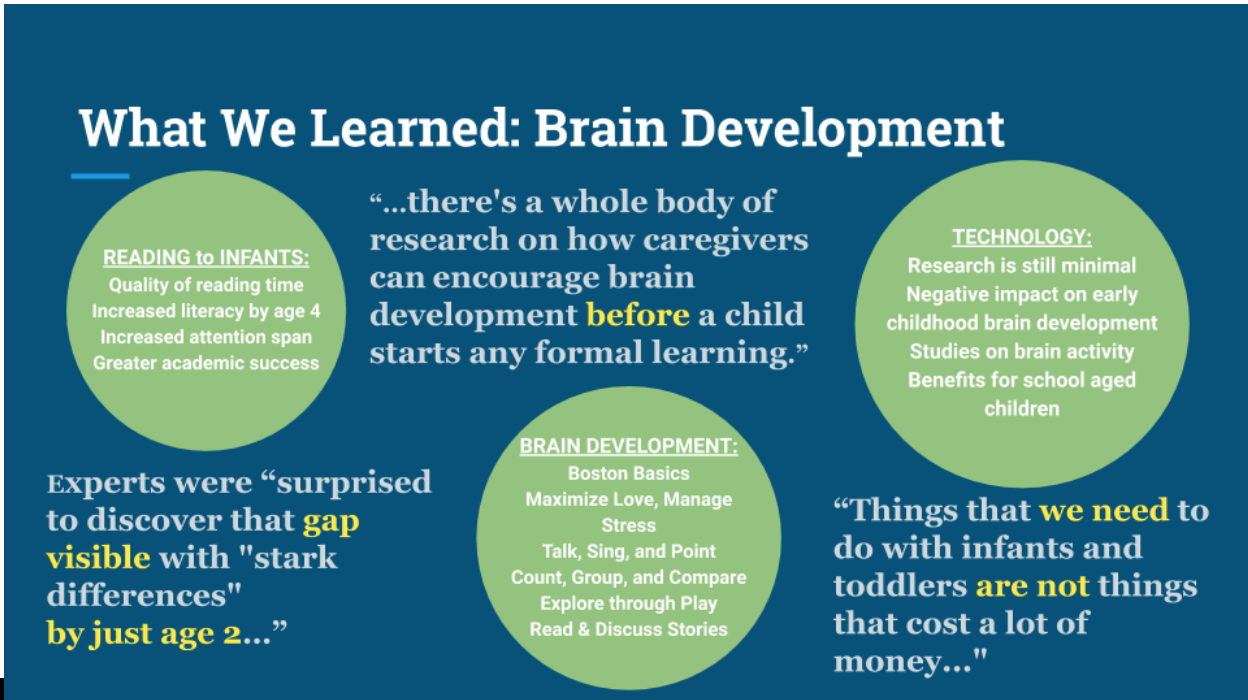Before any prototypes were developed, though, the work began with an exploration of the problem statement and the root causes underneath it.
Ensuring Equitable Access to Opportunity
The equity network focused on developing solutions to tackle the challenge of a lack of equitable access to opportunity for underrepresented students in VBCPS.
The work began with a study of the root causes — why inequities exist, and what we know about them. From there, participants identified dozens of potential solutions to address the root causes.
Two solutions rose to the top: creating stronger early intervention strategies and developing a community liaison or coach position for VBCPS. The equity network divided itself into two groups and got to work developing prototypes for those two ideas. At the end of the 2019 school year, the equity network presented its prototypes to the community advisory group and other members of the Virginia Beach community. Continue reading for a summary of each of the groups’ presentations and ideas.
Prototype One: Creating a Community Liaison position
Presented by Melanie Lee, Tammie Mullins-Rice, Wellinthon Muñoz, David Swanger, Tomeka Wilcher, LaQuiche Parrott, Shana Remain
Tomeka Wilcher, Literacy Teacher at Bayside Middle School and Tammie Mullins-Rice, parent and Program Officer at Obici Healthcare Foundation discuss their prototypes on how to build more equitable systems in VBCPS.
Why It Makes Sense
VBCPS is rife with exciting, specialized learning opportunities for their students, including schools-within-schools programs at the high school level — specific tracks for legal academics, performance arts, STEM, technology, and more. However, not all families and communities are equally benefitting from these programs. This equity group’s proposed solution was creating a new job, a Community Liaison, who would work to close this gap. The Community Liaison would be responsible for building relationships and partnerships with school personnel, students, and parents; employing strong technology skills, communication skills, and presenting skills; and being knowledgeable about the plethora of specialized programs available to VBCPS students, and how to apply.
The equity team worked with the community to see where and how a community liaison could be most helpful.
What They Learned Through Their Prototype
After fleshing out what exactly a community liaison would do, the team held two presentations with the Virginia Beach community to prototype their findings, and for families to learn more about the opportunities available to VBCPS students. During these presentations, it became clear that although parents were somewhat knowledgeable about the programs offered, they did not know how to pursue them or help their children prepare. The parents expressed a desire to know about these specialized programs as soon as possible (even when it comes to opportunities like academies, which are only offered in high school, parents expressed a desire to learn about them in elementary school so that they have time to best help their children). Overall, parents expressed gratitude after the presentations and felt “very informed” about the specialized program offerings.
What’s Next
According to the presenters: it’s clear that VBCPS needs to close the access-to-information gap if they want underrepresented students to have access. The groundwork is set — the specialized programs exist, the emails are sent out, the website is up and running — but for whatever reason, the information is not making its way equally to all students. Here is where the community liaison comes into play: the team recommends VBCPS employ two full-time community liaison positions to support high-need communities. For this position to be successful, s/he must tap into the resources that already exist within communities and form partnerships and trust so families feel comfortable and everyone gets a seat at the table. The group also emphasized that the best person for the job needs to be the right cultural fit; s/he should be embedded in the communities and actively work to make relationships with families. VBCPS should employ a culturally responsive person who will do whatever it takes to bring these underrepresented families into the fold.
Prototype Two: An Emphasis on Early Intervention
Presented by Joyann Drumm, Penney Fonville, Lori Hasher, Krystal Shorts, and Troy Walton
The image above is a slide from the equity early intervention group’s presentation, showcasing what was learned during empathy interviews.
Why Early Childhood?
The second equity group tackled the issue at the very beginning: inequity often begins early, with many students characterized as “at-risk” and already behind before they even begin formal schooling. To learn more about the challenge of early childhood education and development, the team conducted several rounds of empathy interviews with different members of the community, including parents, VBCPS staff, social workers, medical field personnel, non-profit business people, and faith-based leaders and organizations.
What Was Learned
The empathy interviews revealed a lot. First, parents want resources when it comes to what’s best for their young child, but often feel overwhelmed by the slew of information that might be shared at once, for instance, in a pediatrician’s office. Many parents have different-aged children, which adds to the information overload and confusion. VBCPS staff are willing to help, but are concerned about response from parents, some of whom do not wish to be contacted. Social workers have difficulty getting parental follow through. Medical practitioners have information available, but parents are less likely to go to them for education guidance. Non-profit organizations would like to partner with VBCPS if they haven’t already. Faith-based groups often have strong, trusting relationships with the community and could be potentially fruitful partnerships as well.
Troy Walton, Plaza Middle School, Assistant Principal, sharing results from the team’s research.
This slide summarizes the evidence behind how the brain develops in young children and the types of experiences that parents can cultivate for their little ones.
Through interviews with experts, the group also learned that an achievement gap can become visible by just two years old, but there’s so much families can do to close this gap. Caregivers can encourage brain development before a child starts any formal training without spending tons of money, through activities like singing, talking, pointing, counting, grouping, comparing, exploring through play, and, perhaps most importantly, reading and discussing stories. The equity team researched existing Early Childhood Education (ECE) models and found lots of organizations already existing within the Virginia Beach community. They then conducted parent surveys at a VBCPS pre-k registration event, asking parents about the skills and resources they most value and use with their families, where they get their information and resources about how to help with young children, and what obstacles and challenges they face in utilizing these skills with their children. Overwhelmingly, the biggest obstacle uncovered was time. Some families are already using the recommended skills, particularly of reading and interactive play, but they’re limited by everyday time constraints. What became abundantly clear, though, was that the biggest challenge was how to get information into the hands of underserved parents.
VBCPS would act as the resource “hub” that connects ECE resources (including doctors’ offices, labor & delivery, non-profits, etc.) and the community of new and existing families.
What’s Next?
Given that challenge, the team recommends that VBCPS expand the pathways to the early childhood resources that already exist and make them more readily available for families with young children. To do this, the team proposes the creation of an Early Intervention Task Force. This task force would partner with existing early childhood education resources and create inviting experiences within the school system that encourage parents to embrace skills and strategies.
The task force could lead to an integrated community of resources and families that need them, a greater awareness of the formative years for young children in building the foundational connections for learning, and a positive message to parents that they have the support to help them in the unique journey of raising a young family. Additionally, these efforts could create a normalized culture of utilizing resources through VBCPS and providing opportunities for increased school readiness, benefitting the families, children, and staff and teachers of VBCPS.As more families become aware of the importance of these first years, the hope is that they connect to VBCPS much earlier as a centralized resource for what is available. And this, in turn, would bring an increase in school readiness for the youngest citizens, increasing capabilities of the VBCPS teachers, resources, and overall community.








